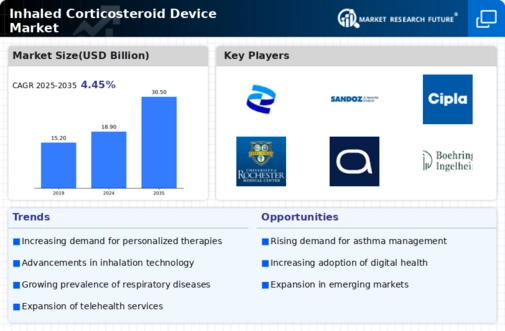Market Growth Projections
The Global Inhaled Corticosteroid Device Market Industry is poised for substantial growth, with projections indicating a compound annual growth rate (CAGR) of 4.45% from 2025 to 2035. This growth trajectory reflects the increasing demand for inhaled corticosteroid devices driven by various factors, including the rising prevalence of respiratory diseases and technological advancements. As the market evolves, stakeholders are likely to witness significant opportunities for investment and innovation. The anticipated market value of 30.5 USD Billion by 2035 underscores the potential for expansion and the importance of addressing the evolving needs of patients and healthcare providers in this sector.
Increasing Geriatric Population
The aging population worldwide is a significant driver of the Global Inhaled Corticosteroid Device Market Industry. Older adults are more susceptible to respiratory diseases, necessitating effective management solutions. As the geriatric population continues to grow, healthcare systems are focusing on providing tailored treatments that address the unique needs of this demographic. Inhaled corticosteroids are often prescribed to manage chronic respiratory conditions prevalent among older individuals. Consequently, the demand for inhaled corticosteroid devices is likely to rise, reflecting the need for effective therapeutic options for an aging population. This trend underscores the importance of addressing the healthcare needs of older adults in the market.
Regulatory Support and Approval Processes
Regulatory support and streamlined approval processes contribute positively to the Global Inhaled Corticosteroid Device Market Industry. Governments and health authorities are increasingly recognizing the importance of inhaled corticosteroids in managing respiratory diseases. This recognition leads to expedited review processes for new devices and formulations, facilitating quicker access to innovative treatments. As regulatory bodies continue to support the development of inhaled corticosteroid devices, manufacturers are encouraged to invest in research and development. This environment fosters innovation and enhances the availability of effective treatment options, ultimately driving market growth and ensuring that patients have access to the latest advancements in inhaled corticosteroid therapy.
Rising Prevalence of Respiratory Diseases
The Global Inhaled Corticosteroid Device Market Industry is experiencing growth due to the increasing prevalence of respiratory diseases such as asthma and chronic obstructive pulmonary disease (COPD). According to health data, millions of individuals worldwide are diagnosed with these conditions, necessitating effective management strategies. The rise in air pollution and allergens contributes to this trend, prompting healthcare providers to recommend inhaled corticosteroids as a primary treatment option. As a result, the demand for inhaled corticosteroid devices is projected to rise, with the market expected to reach 18.9 USD Billion in 2024, reflecting a growing need for effective therapeutic solutions.
Growing Awareness and Education Initiatives
The Global Inhaled Corticosteroid Device Market Industry is bolstered by growing awareness and education initiatives aimed at patients and healthcare professionals. Organizations and health authorities are actively promoting the importance of proper inhaler technique and adherence to prescribed therapies. Educational campaigns help demystify inhaled corticosteroids, ensuring that patients understand their benefits and usage. This increased awareness is likely to lead to higher adoption rates of inhaled corticosteroid devices, contributing to market growth. As more individuals become informed about their treatment options, the market is expected to see a steady increase, with projections indicating a market value of 30.5 USD Billion by 2035.
Technological Advancements in Device Design
Technological innovations play a crucial role in the expansion of the Global Inhaled Corticosteroid Device Market Industry. Recent advancements in device design, such as the development of smart inhalers equipped with sensors and connectivity features, enhance medication adherence and patient monitoring. These devices provide real-time feedback to users, potentially improving treatment outcomes. As healthcare systems increasingly adopt digital health solutions, the market is likely to benefit from these innovations. The integration of technology into inhaled corticosteroid devices not only improves patient experience but also aligns with the global trend towards personalized medicine, further driving market growth.






















